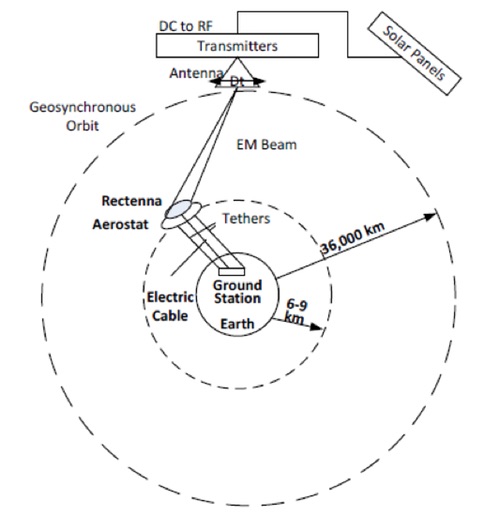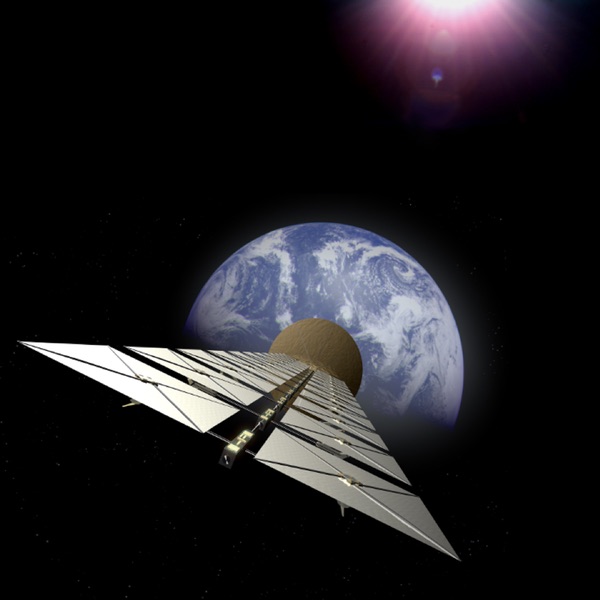Space power: a timely answer to Europe’s energy challengeby Vidvuds Beldavs
|
| Development of SBSP is a multi-faceted all-Europe and international challenge. It could inspire a generation of scientists and engineers across scores of disciplines. |
Energy security and climate change, however, are central concerns of the EC. Space-based solar power (SBSP) offers solutions to Europe’s energy problematique while contributing to the industrial development of the Moon. Eventually resources from the Moon could be used to build solar power satellites to meet energy needs on Earth. This could eliminate all carbon dioxide emissions from production and preserve the Earth from environmental harm from mining and heavy industry.
Development of SBSP is a multi-faceted all-Europe and international challenge. It could inspire a generation of scientists and engineers across scores of disciplines. Industrial development of the Moon would call on specialists in mining, manufacturing and even ecology and farming as teams on the Moon would need to grow food from lunar soils.
SBSP background
Peter Glaser, a Czech-born and educated scientist, invented the solar power satellite after emigrating to the US. He was granted a US patent in 1973. Over the decades SBSP has attracted considerable interest in the US, Japan, China, and Europe.
Solar power satellites would transmit power from geosynchronous orbit, where intensive sunlight is available around the clock, to the surface. Transmission such a distance at frequencies that can penetrate the atmosphere with low losses requires very large transmitting and receiving antennas which, in turn, require very large solar arrays for the effort to be worthwhile.
High costs to launch components from Earth to orbit has so far blocked commercial development of SBSP. Expected significant reductions in launch costs from the present more than €5,000 per kilogram to less than €1,000 per kilogram suggest that ESA and the EC need to reassess SBSP as an energy option for Europe.
Compelling reasons to now develop SBSP
- Energy beamed from orbit generates no carbon dioxide and would be the ultimate solution to decarbonize the economy, if lunar resources were used to build the powersats;
- The sun shines 24/7 in space at an average intensity nine times that on the surface after accounting for nighttime and weather, requiring much smaller arrays than on Earth for comparable power;
- Power can be switched to any point within the footprint of the satellite, opening the possibility of using SBSP for peak-shaving as well as enabling rapid response to deliver electrical power for disaster recovery to save lives and cut costs;
- Analytic forecasts of levelized costs of electrical power delivered from SBSP show that $.10 per kilowatt-hour can be attained a current launch costs and that $.05 per kilowatt-hour could be attained at launch costs in the range of $1,600 per kilogam. This would be highly competitive with conventional solar, wind, and even coal1 ;
- Energy payback for SBSP system is estimated at nine months compared to 18 months for grid-connected terrestrial solar;1
- The useful life of SBSP systems can potentially be extended to 50 or more years through replacement and recycling of modules. Spacecraft and satellites have already demonstrated service lives in the decades. Improved materials and highly modular designs that can be serviced using autonomous robots can extend lifetimes indefinitely. SBSP would be more like hydropower than coal or nuclear, which have service lives of 30 years or less. Infrastructure that has very long service lives can be financed with long term financing on more favorable terms that do not have to consider decommissioning costs.1
Microwave or laser power beaming?
Power can be transmitted wirelessly from orbit using microwaves or using lasers. Neither are ionizing radiation and are not a danger to people, animals, and plants. Microwave beams at frequencies of one to 10 gigahertz travel through the atmosphere with no loss in efficiency. However, the microwave transmitter in orbit and the rectenna on the surface are huge: 1,700 meers and 6,000 meters, respectively, in the latest design offered by John Mankins.
| One approach to introduce disruptive technology into the market is to start with high value uses that can generate larger revenue per unit sold to attract financing and cover development costs. |
Laser beams at much higher terahertz frequencies have significant losses in transmission through the lower atmosphere but have the advantage that transmitters can be a few meters in diameter and the rectenna on the surface about 50 meters. This could substantially lower construction costs and widen opportunities for deployment of rectennas near cities.
When costs of power delivered from SBSP would become competitive for utility customers, then large powersats that can deliver two gigawatts or more of power will become feasible. For such large systems the higher end-to-end efficiency of microwave power-beaming may favor its use. By 2050 SBSP could supply a significant share of Europe’s power, generating trillions of euros in revenue.
Market entry
One approach to introduce disruptive technology into the market is to start with high value uses that can generate larger revenue per unit sold to attract financing and cover development costs. Market entry of SBSP can be achieved by initially serving applications where power is very costly. Two prospective markets include disaster recovery and power for space applications, particularly for lunar industrial development.
Power-beaming to an aerostat
This approach features transmission of the laser beam to a rectenna positioned on an aerostat above the cloud layer as in Figure 1. This minimizes losses in the atmosphere and lessens possible hazards to health. Other advantages of this approach include portability, enabling SBSP to provide power for rapid response for disaster recovery2 as the aerostat can be rapidly moved to a disaster site.
 Figure 1: SBSP laser beam to tethered aerostat. (credit: NASA) |
Major natural disasters are extremely costly in lives as well as material costs, the latter sometimes in the hundreds of billions. Recovery is hampered by poor access to electrical power and other energy sources. Electricity can cost $3–5 per kilowatt-hour, a multiple of even high costs for grid power in Europe. Gasoline, diesel, jet fuel, and compressed natural gas can cost many times regular pricing when delivered to disaster zones. SBSP can potentially deliver electricity to disaster zones more rapidly than alternative such as shipping in diesel generators. Speed of recovery is critical to save lives and to reduce overall costs.
The ability to rapidly provide electrical power to a disaster zone can be augmented by use of all electrically powered vehicles and equipment to dramatically improve response capability. The cost of developing SBSP for disaster recovery could potentially be recovered through savings and benefits in a single major disaster. The EU is already active in disaster recovery by providing technology through the UN SPIDER program for monitoring disaster zones and providing communications services.
Lunar power utility
Similar laser power beaming technology used for disaster recovery could be used to speed up exploration and development of the Moon, reducing costs and improving returns on investment. Technology to achieve this has been proposed by NASA scientist Jim Schier.3 A major challenge to industrial development on the Moon is the 14-day lunar night, when temperatures can drop to –173°C from the daytime’s +127°C. Electrical power, or concentrated sunlight delivered from orbit to the lunar surface, could provide power through the lunar day and night.
A lunar power utility that would enable customers to “plug-in” and avoid building or bringing their own power plants could dramatically accelerate lunar development. Energy infrastructure is key to lunar development. Availability of electrical power on the Moon could enable propellant-less launch from the Moon using electromagnetic catapults or beaming power to spacecraft for a “beam launch.” As these technologies are improved, launch costs from the Moon can be decreased to a small fraction of launch costs from the Earth. The availability of increasingly lower cost power on the Moon would enable construction using lunar materials of very large energy, industrial, research, and touristic facilities in Earth orbit.
Power beaming developed to meet very high value needs for power for disaster recovery as well as on the Moon could be productionized to produce SBSP systems that can meet energy needs on Earth without generating greenhouse gasses at costs less than generating electrical power from coal.
COMSAT offers one model for how Europe can realize SBSP
COMSAT was a publicly-held company chartered by an act of the US Congress in 1962 to develop satellite communications. Major telecommunications companies and private investors held shares. COMSAT in turn played a role in the startup international satellite communications including INTELSAT, which was later privatized as the commercial satellite communications industry grew.
| The EU has the opportunity now to lead SBSP development by initiating a Europe-wide SBSP Flagship that invites international participation. It should seize the chance while the US, China, Japan and India continue to evaluate the prospects. |
A consortium of European utilities and major suppliers could form the Space Power Corporation (SPC) with the support of the EC with the goal to deploy SBSP for baseload power to help assure net-zero-carbon energy by 2050. EC support and initial public funding from the European Investment Bank’s structured finance program for European-scale energy and transport infrastructure can be leveraged by private investment to develop SBSP on an accelerated schedule.
Foresight analysis of SBSP points to the potential to meet 15 percent of EU electrical power demand by 2050 with the prospect for declining costs of delivered electrical power as lunar industries mature.
SPC Roadmap
| Early 2020s | SBSP using laser power beaming to tethered aerostat for power for disaster recovery |
| Mid 2020s | Deploy initial system for lunar power (150KW) |
| 2030 | MW scale SBSP for lunar development |
| 2030 | Utility scale SBSP |
| 2040 | Use of lunar resources to build SBSP systems for power for Earth |
We can be confident that major disasters will occur in coming years where the capacity to rapidly deliver electrical power for recovery could prove invaluable. The lunar power utility could strongly accelerate lunar development, opening opportunities for small and medium enterprises and small EU member states as well as for developing countries. Outer space and the Moon would not just for billionaires and NASA.
SBSP would have multiple other advantages for Europe. The capacity to beam power to regions in Africa that presently have inadequate infrastructure and poor access to electricity could accelerate their economic development and lessen pressures to migrate to the EU.
SBSP is a true Moon shot!
SBSP offers the opportunity to link lunar development to UN Sustainable Development Goals in which climate action and poverty reduction are central. SBSP can deliver carbon-free energy to less developed regions of the world with inadequate infrastructure that are often impacted by natural disasters.
The EU has the opportunity now to lead SBSP development by initiating a Europe-wide SBSP Flagship that invites international participation. It should seize the chance while the US, China, Japan and India continue to evaluate the prospects. In a few years the cost of leadership will be much higher and by then may already have been seized by the US or China.
This article was first published on June 29, 2018 in the Euractive blog "Space power - a timely answer to Europe's energy problematique"
Endnotes
- John Mankins, “New Developments in Space Solar Power”.
- Stephen J. Blank, Steven J. Leete, and Paul Jaffe “Feasibility Study of Space Based Solar Power to Tethered Aerostat Systems”.
- Jim Schier “Concept for a Lunar Power and Communications Utility”.
Note: we are temporarily moderating all comments subcommitted to deal with a surge in spam.
